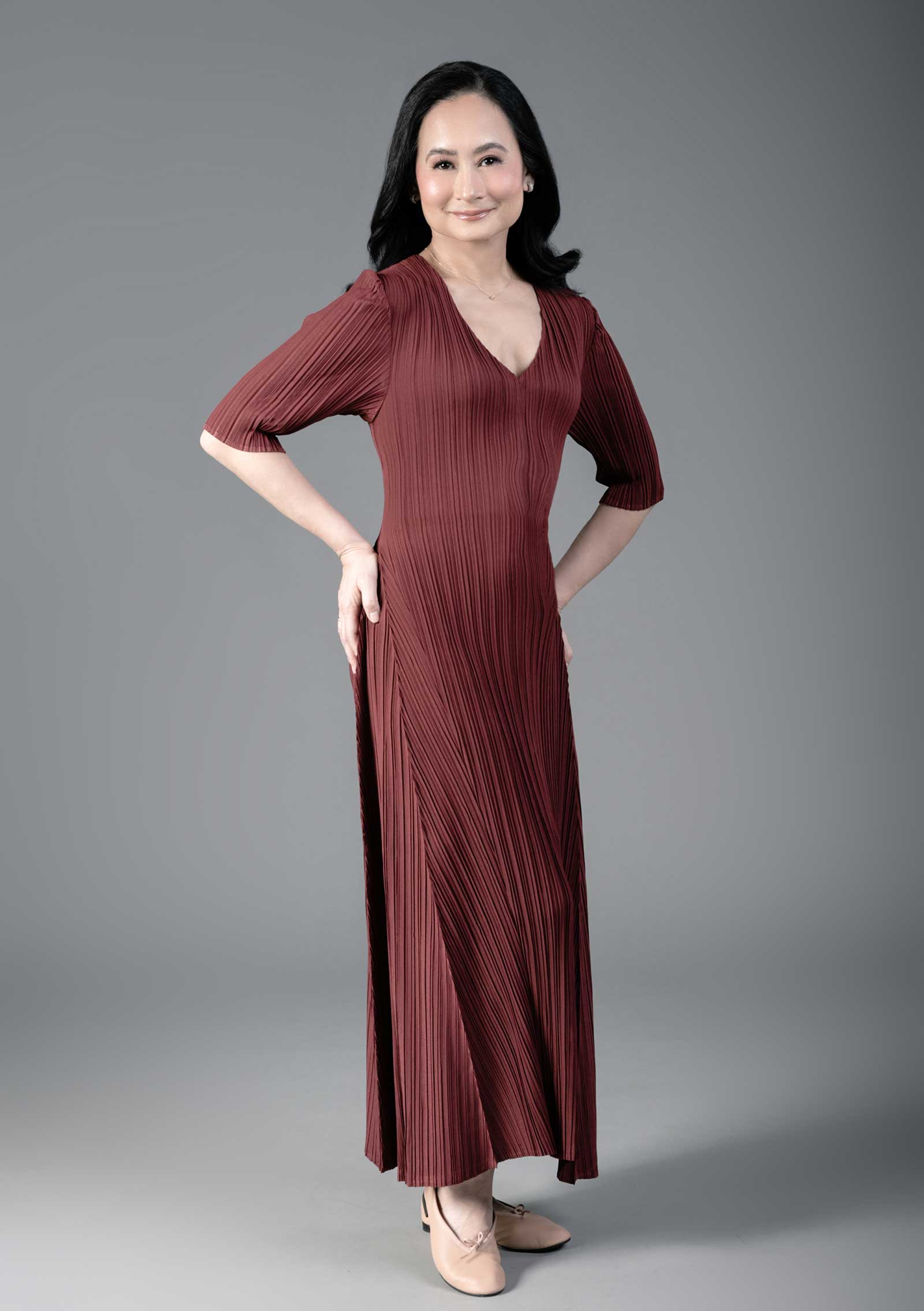Courtesy of Lisa Macuja
Lisa Macuja Elizalde finds new footing on an unlikely stage: Tiktok. The “ballerina of the people” brings ballet education to the world as an act of resistance to instant gratification.
Visit vogue.ph everyday this month for daily features on inspiring women, as nominated by the people whose lives they’ve changed.
The name “Lisa Macuja” has been immortalized in textbooks. The prima “ballerina of the people” is credited for raising awareness about the European art form among the Filipino masses through her mainstream media fame and countless outreach performances. But while a privileged few can claim to be a cultural icon, much less part of the school curriculum, Macuja (now also Elizalde) refuses to rest on her laurels. Recently, she’s taken on arguably her most challenging role yet: as a TikToker.
“TikTok was an alien application!” she exclaimed. Learning the app wasn’t as easy as going from first to fifth position. “But as an artist, and mentor, you want to have the reach.”
With the help of her team, Macuja, who turns 60 this year, learned to set up her camera and microphone. She acquainted herself with framing her dainty, 5-foot physique into the small screen. Her face is stern as she bent her toned legs meticulously on camera, lecturing her invisible audience about the proper form.
Using the handle @lisamacujaballerina on both Instagram and TikTok, she regularly uploads content: follow-along exercises and tips on doing fouetté turns or triple pirouettes — adding grace and finesse to the constant feed of viral pop bop challenges on the dance-centric app. (She is also quite active in the comments section.)
Now, Macuja radiates when she talks about her digital presence. She even has a Google Form called Ask Teacher Lisa, which collects questions from her followers whom she answers through email or via her vertical sixty-seconders. Her eyes twinkle while she recounts how she’s met several of them in real life, including parents and girls hailing from all over the world. On a trip to Singapore last November, a judging stint at the International Arts Festival, a girl about 8 wearing a Sleeping Beauty costume introduced herself, “Ma’am Lisa, I am Melvina!” The name automatically registered to Macuja: “the one who asked about the Princess Aurora Act III variation!”
These real-life encounters with her followers validate her pandemic reflection: “[with] the screen and the power of social media,” Macuja said, “you can be an effective teacher to girls and boys all over the world.”
Asian ballerina
While most of the population was cloistered at home at the height of COVID-19, Macuja took over Zoom, teaching students as far as Europe, the birthplace of ballet.
Perhaps the most pivotal moment in Macuja’s career was when she met Yoko Morishita, Japan’s pioneer prima ballerina, at a performance at the Cultural Center of the Philippines. Macuja was all of 14, enamored by the 4-foot 11-inch Morishita, who used her doll-like charm in portraying a role traditionally associated with Caucasians. “That’s the reason I went into classical ballet,” she said. “Yoko Morishita showed me that it’s possible for an Asian ballerina to dance well in the classics.”
In 1976, dance critic Clive Barnes in the New York Times described Morishita’s physique as “not perfect—a slightly short torso—but, in fact, most of the world’s greatest dancers have started with physical deficiencies. Her style is virtually impeccable, allowing for a certain discrepancy in her line. She has all the makings of a major ballerina.”
Similarly, Macuja used her Asian features to her advantage. “Because I am small, I was able to jump higher and faster,” she explained. “My muscles made me light and fast. I had a very ‘athletic’ performance.”
At the age of 18, Macuja accepted a scholarship at the Leningrad Choreographic Institute, the revered school of classical ballet in Saint Petersburg now known as the Vaganova Academy of Russian Ballet. She graduated top of the class (in a record two years versus the average eight) and went on to become the first foreigner to be invited as soloist by the Kirov, now Mariinsky, Ballet.

It is widely known that after four years in Russia, Macuja returned to the Philippines. But that almost didn’t happen. During a visit to Russia, Sir Peter Wright, then-artistic director of Sadler’s Wells Theater Ballet (now Birmingham Royal Ballet) met Macuja and offered her to continue her career in London. When Macuja finished her season at the Kirov Theatre in June of 1986, she flew to the U.K. and sat with Wright in his office—only to learn that the board couldn’t hire a Philippine passport holder.
“They needed me to either graduate from an English ballet school or marry an Englishman,” she recalled. “At that time, they had to prove to the home office that no other British citizen can take my place—which Miss Saigon and Cameron Macintosh were able to do because they auditioned all over the world before they zeroed in on Lea Salonga.” Unfortunately, the ballet company didn’t have the same resources.
“It was a technicality, and at that time, a huge tragedy,” she said. “But it was one of the luckiest things to happen, that kind of rejection, because it made me come home.”
Ballerina of the people
Upon her return, Macuja became the first artist-in-residence of the CCP and guest artist with Ballet Philippines—a role she held for two years until she became a principal dancer of the Philippine Ballet Theatre.
Alongside Osias Barroso Jr., who passed away in December, and ten other young dancers, she founded Ballet Manila, which now counts more than 5,000 local performances and outreach programs. She also went beyond the stage and appeared on television, among other non-traditional venues.
Still, invitations to perform abroad kept coming. She took on principal roles in various countries, including places like Cuba, Mexico and Armenia. “When Yoko Morishita showed me when I was 14 that ‘you can dance Swan Lake even if you’re tiny’, my only dream was to dance Swan Lake once. Just once!”
Today, Macuja has danced the full-length Swan Lake more than 20 times. Don Quixote, over a hundred. In total, Macuja has been the lead of over 300 full-length ballets. “My reality has far exceeded my wildest dreams.”
Her former student, veteran model and UN Women champion Rissa Mananquil-Trillo looks up to her teacher as a bastion of empowerment: “Ballet has a reputation as an art form reserved for the elite, but Lisa broke down economic barriers and democratized access.”
The people’s ballerina hasn’t only inspired fellow dancers, but also generations of girls enthralled by her power and strength. “Engaging in ballet demands an incredible amount of poise and precision, but it empowers women to develop a sense of control over their bodies. Ballet shows you how strong and powerful a woman’s body is. There are a lot of physical and mental hurdles in any dancer’s pursuit of excellence in ballet, but overcoming these genuinely develops a strong sense of self-confidence,” Mananquil-Trillo said. “Through Lisa, I’ve witnessed how dance, as a universal language, has the power to transcend boundaries.”

In 2012, then-senator Miriam Defensor-Santiago filed a resolution urging then-President Benigno Aquino III to confer Macuja the National Artist award. In the 15th Congress – Senate Resolution No. 808, she hailed the ballerina as “the embodiment of talent, creativity and imagination[;] [and] technical proficiency of the highest order, grace, and humanity.” Both politicians have passed—but the resolution remains pending and the recognition, long overdue.
Macuja, meanwhile, isn’t hanging up her ballet shoes anytime soon. (Though these days, her footwear of choice are pink split-sole Bloch sneakers.) She may have retired from the stage, but she teaches six days a week—Tuesdays to Sundays—at her eponymous school where she sits as director. She remains at the helm of Ballet Manila as its artistic director and CEO. She also hosts a show, DZRH News’ Art2Art with Lisa Macuja Elizalde, which airs and streams every Sunday.
“My school and my company are my legacy,” Macuja says. “I am enjoying more success now as a mentor.” That school has transcended the confines of a ballet studio as she expands her online reach and remains a living inspiration to legions of girls, locally and abroad, who wish to become prima ballerinas—just as the Japanese Yoko Morishita was to her when she was a wide-eyed teenager at the CCP.
“But there’s nothing like face-to-face,” she cautions. “Nothing like looking straight at your students, being in the same room, conducting a class or watching a performance. But having said that, there are other ways to teach, mentor and perform.”
“Ballet is an art form that is passed down from one generation to the next,” Macuja says. Gone are the days of ballet being reserved in the French courts of King Louis XIV… or in the CCP. As Macuja democratized ballet education in the ‘90s, so is she keeping it accessible today—as a TikToker.
For someone who is no stranger to the world’s most prestigious theaters, moving to the small screen might seem like a demotion. But it is through new media that Macuja stays relevant in an ever-changing world.
This is especially crucial as the pandemic puts culture at risk. It has already forced theaters to close down, festivals to get canceled, and cultural workers to lose their source of income. Putting classical ballet on TikTok is not only an act of preservation, but also an act of resistance: in an era of instant gratification, Macuja is cultivating appreciation for an art form that requires discipline, patience, practice and perseverance.
TikTok is a new stage that keeps the ballerina of the people on her toes. To her, “It’s a whole new world to conquer.”
- The Next Frontier for Representation in Ballet? Emojis. Let Misty Copeland Explain
- Stella Abrera Charts A Path For The Next Generation Of Filipino Ballet Stars
- The American Ballet Theatre Studio Company Marks Its Benefit Performance This Month With A Gala
- The Global Rising Stars Of Classical Ballet Take Center Stage With The American Ballet Theatre Studio Company
